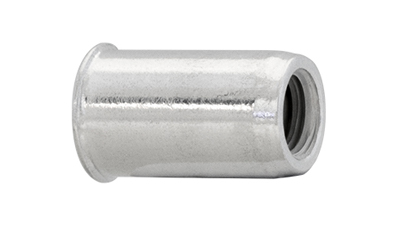
Call them what you will, if you want to get a female threaded nut into sheet metal they work really well.

Insert the Threaded Insert (Nutsert) into a hole drilled in the sheet metal or metal section.
Then using a Threaded Insert Tool, pull the nutsert up (like a rivet) to grip onto the sheet metal and the nutsert is locked in place.
Stainless Threaded Inserts (Nutserts) are commonly used in places where it is hard to get behind the sheetmetal, such as installing glass clamps onto stainless steel stanchions and hollow sections.
For example, when installing a balustrade system with stainless steel upright posts for glass clamps or wire fittings to screw into.
Nutserts are available in Stainless Steel or Aluminium (depending on their purpose). They come in Rimless (a small countersunk edge) for a flush finish or flanged. Aluminium and Stainless Steel Riv-nuts (Rivet Nuts) Dimensions are noted by their grip range - this is the thickness you want to grip (so if it is to clamp through 2 sheets of 3mm stainless then the grip range needs to suit 6mm) and their thread size - the size of the internal thread you are bolting into (e.g M4-M12).
For low load applications Aluminium Nutserts are nice and easy to install, but for higher load applications Stainless Steel is ideal with Nutsert Strength Data.
Also available are sealed riv nuts which prevent any fluid from leaking through and hex riv nuts which lock in place even more securely.
Another option you might go for into sheet metal is a Stainless Steel Hank Bush or Dunk Nut. These are hammered in place and have an internal female thread.
OR if you are wanting to screw into timber and create an internal machine thread, you will want to look at Stainless Tee Nuts or Stainless Wood Inserts.
Build Your Deck Faster With Our Decking Screw Calculator
Super Duplex 2507 Stainless Steel for Engineering & Manufacturing
To receive useful info and product updates add your details below